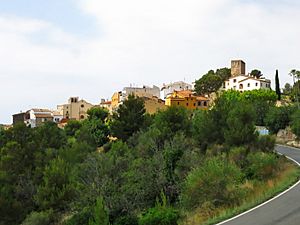Sant Vicenç de Calders facts for kids
Quick facts for kids
Sant Vicenç de Calders
|
|
|---|---|
|
Village
|
|

Sant Vicenç de Calders
|
|
| Country | Spain |
| Autonomous Community | Catalonia |
| Province | Tarragona |
| Comarca | Baix Penedès |
| Municipality | El Vendrell |
| Elevation | 100 m (300 ft) |
| Population | |
| • Total | 100+ |
| Time zone | UTC+1 (CET) |
Sant Vicenç de Calders is a small village located in the El Vendrell area of Spain. It is part of the Baix Penedès region in the Province of Tarragona. This charming village was once a separate town until the 1940s. It sits about 3.4 kilometers (2.1 miles) southeast of El Vendrell. Today, just over one hundred people call Sant Vicenç de Calders home.
The village is built on a hill about 100 meters (328 feet) high. You can find many houses from the 1700s around the main square. The village church, dedicated to St Vincent, has been around since the 11th century. It was rebuilt in the 18th century. From its high spot, the village offers great views of the nearby coastal area of Coma-ruga.
The Sant Vicenç de Calders Railway Junction
In the late 1800s, trains arrived in the Sant Vicenç de Calders area. This led to the creation of an important train junction. Here, two major railway lines met. One line connected Barcelona to Tarragona. The other linked Barcelona to Valls.
The train station was built about 3 kilometers (1.9 miles) from the main village. A new community, called the barri de l'estació (station neighborhood), grew up around this busy station. It became a small railway town because of all the train activity.
Historical Impact of the Junction
During the Spanish Civil War, the Sant Vicenç de Calders railway junction was a very important target. Because of its key role in transportation, it was attacked many times. These attacks caused a lot of damage and affected many people.
One of the most serious events happened on October 8, 1938. This attack caused the most harm, impacting many civilians. In total, these events led to the deaths of 83 people and injured over 200 others. The railway junction remains a significant historical site due to its role during the war.
See also
 In Spanish: San Vicente de Calders para niños
In Spanish: San Vicente de Calders para niños

